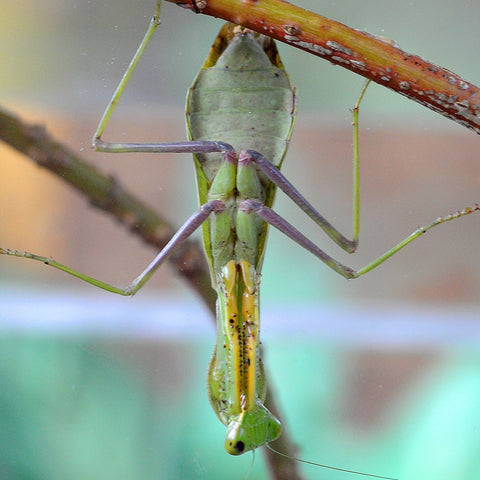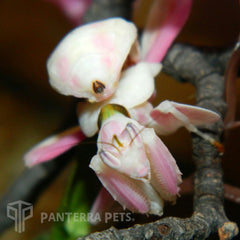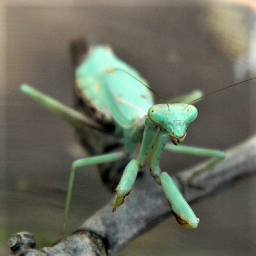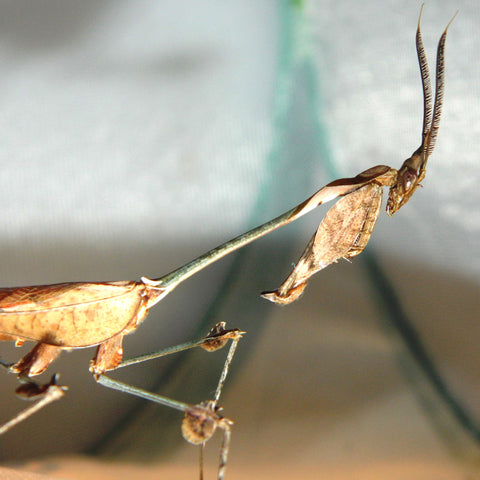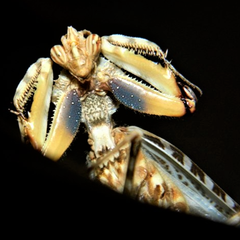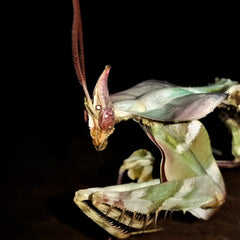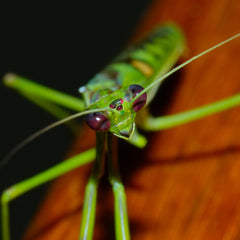General Mantis Care
Housing
All mantises should be kept in individual enclosures, unless otherwise specified in the species caresheet. The enclosure should be at least 3 times as tall as the mantis is long, and at least 2 times as wide as the mantis is long.
The enclosure must have adequate ventilation, but can be glass, acrylic, or a screen or mesh cage. The best cage for your individual mantis largely depends on its species. (Please see our caresheets for individual species, below.) No matter what kind of enclosure you use, it is essential that it has some kind of mesh material on the top of it from which the mantis can hang upside down and molt, as well as an empty space directly below which is at least 2 times the size of the mantis.
We prefer to keep our praying mantises in living vivariums with live plants and microfauna (springtails and isopods), but mantises can also be kept in temporary enclosures with fake plants and no substrate, or with just a paper towel or some other kind of substrate at the bottom of the enclosure. However, if you choose to take this route, you must be very diligent about cleaning the enclosure and replacing the substrate once a week; without microfauna to help keep waste like frass (bug poop) and food scraps (feeder insect parts) in check, mold and bacteria can readily grow in the enclosure, and can easily kill any mantis.
Temperature & Humidity
Temperature and humidity requirements can vary widely, depending on the species of mantis you are keeping. (Please see our caresheets for individual species, below.) However, most mantises will do fine at room temperature or slightly higher, and a small desk lamp with a low wattage bulb will often provide a suitable amount of heat. Humidity around 40% - 60% relative humidity (RH) is generally fine, and a regular humidifier in the room can be helpful to balance the moisture lost to your heating or A/C system, if necessary.
Most mantises will appreciate a light misting of their enclosures once a day so they can drink. But, most mantises do not like getting sprayed directly, so it is best to try and spray around the mantis. If you happen to get them a little wet by accident, it is usually no big deal.
For mantises kept in enclosures with glass or acrylic sides, it is best to mist once every 2 - 3 days as the lower ventilation means it will hold the humidity longer. Mantises kept in mesh or screen cages should have their enclosures misted once a day. In the summertime, when the room gets extra warm during the day, we usually mist mesh or screen cages twice a day.
Use spring water, distilled water, or water filtered by reverse osmosis (RO), but it is best to avoid tap water.
Feeding
Most mantises prefer flying insects throughout their entire life cycles, though many species are perfectly willing to eat crickets and cockroaches as well. If you plan to feed them crickets or cockroaches, it is especially important to provide proper nutrition and living conditions for your feeders, as most mantises are very sensitive to any bacteria that feeder insects might transmit when kept in unsanitary conditions. Also, certain foods, such as carrots, should not be fed to your feeders, because they can make your mantis sick. We recommend using Repashy SuperFly for your fruit fly cultures, and Repashy Bug Burger for feeder insects like crickets and cockroaches. Both of these products are available in our store for your convenience.
- L1 and L2 nymphs: Should be fed D. melanogaster fruit flies.
- L3 and L4 nymphs: Should be fed D. hydei fruit flies.
- L5 nymph to adult: Should be fed house flies, hover flies, blue bottle flies, green bottle flies, butterflies, moths, crickets or cockroaches.
Many mantises will benefit from being fed honey on occasion, especially when they are not feeling well. You can also feed them a powdered mix of honey powder and bee pollen on occasion. You can dust your feeder insects with the powder by misting the feeders lightly, then pouring the dry powder over the feeder insect. Or, you can wet a toothpick slightly, dip it in the powder, then hand-feed the mantis the moist powder from the toothpick.


